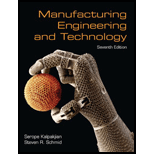
Manufacturing Engineering & Technology
7th Edition
ISBN: 9780133128741
Author: Serope Kalpakjian, Steven Schmid
Publisher: Prentice Hall
expand_more
expand_more
format_list_bulleted
Concept explainers
Textbook Question
Chapter 31, Problem 19QLP
Explain the similarities and differences between the joining processes described in this chapter and those in Chapter 30.
Expert Solution & Answer
Trending nowThis is a popular solution!

Students have asked these similar questions
A resistance welding is performed to join two 2-mm thick stainless steel sheets with ten 6-mm diameter spot welds produced concurrently. The resulted weld nugget each has average 3 mm in thickness. Calculate the required welding current and energy consumption for the welding if ten seconds are needed for the whole welding operation. Given that the applied voltage is 10 V. Provide TWO important assumptions in your calculation.
What do you understand by the term welded joint? How it differs from riveted joint?
Explain the residual stress in weldin operations. What kind of geometries or machine elements are likely to suffer from residual stress? Give your opinions on avoiding this problem ?
Chapter 31 Solutions
Manufacturing Engineering & Technology
Ch. 31 - Explain what is meant by solid-state welding.Ch. 31 - What is cold welding? Why is it so called?Ch. 31 - What is (a) a ferrule, (b) filled gold, and (c) a...Ch. 31 - What are faying surfaces in solid-state welding...Ch. 31 - What is the basic principle of (a) ultrasonic...Ch. 31 - Explain how the heat is generated in the...Ch. 31 - Prob. 7RQCh. 31 - Describe the principle of resistance-welding...Ch. 31 - Prob. 9RQCh. 31 - What type of products are suitable for stud...
Ch. 31 - Prob. 11RQCh. 31 - Prob. 12RQCh. 31 - Prob. 13RQCh. 31 - Describe how high-frequency butt welding operates.Ch. 31 - What materials are typically used in...Ch. 31 - Make a list of processes in this chapter,...Ch. 31 - Prob. 17QLPCh. 31 - Explain the reasons why the processes described in...Ch. 31 - Explain the similarities and differences between...Ch. 31 - Describe your observations concerning Figs....Ch. 31 - Would you be concerned about the size of weld...Ch. 31 - What advantages does friction welding have over...Ch. 31 - Prob. 23QLPCh. 31 - Prob. 24QLPCh. 31 - Discuss the factors that influence the strength of...Ch. 31 - What are the sources of heat for the...Ch. 31 - Can the roll-bonding process be applied to a...Ch. 31 - Prob. 28QLPCh. 31 - List and explain the factors involved in the...Ch. 31 - Give some of the reasons that spot welding is...Ch. 31 - Prob. 31QLPCh. 31 - Prob. 32QLPCh. 31 - Prob. 33QLPCh. 31 - Prob. 34QLPCh. 31 - Prob. 35QLPCh. 31 - Prob. 36QLPCh. 31 - Prob. 37QLPCh. 31 - Prob. 38QLPCh. 31 - Which processes in this chapter are not affected...Ch. 31 - Consider the situation where two round...Ch. 31 - Prob. 41QLPCh. 31 - The energy required in ultrasonic welding is found...Ch. 31 - Prob. 43QTPCh. 31 - Prob. 44QTPCh. 31 - Prob. 45QTPCh. 31 - Prob. 46SDPCh. 31 - Explain how you would fabricate the structures...Ch. 31 - Prob. 48SDPCh. 31 - Prob. 49SDPCh. 31 - Prob. 50SDPCh. 31 - Prob. 51SDPCh. 31 - Prob. 52SDPCh. 31 - Prob. 53SDPCh. 31 - Describe the methods you would use for removing...Ch. 31 - Prob. 55SDPCh. 31 - Prob. 56SDPCh. 31 - Inspect the sheet-metal body of an automobile,...Ch. 31 - Prob. 59SDPCh. 31 - Prob. 60SDPCh. 31 - Sketch the microstructure you would expect if a...
Knowledge Booster
Learn more about
Need a deep-dive on the concept behind this application? Look no further. Learn more about this topic, mechanical-engineering and related others by exploring similar questions and additional content below.Similar questions
- Explain with neat sketch, the joining process of “Riveting”.arrow_forwardExplain the mechanism of heat generation in Resistance spot welding. Explain the Force (current) vs time diagram.arrow_forwardExamine various household products and describe how their components are joined and assembled. Explain why those particular processes were used and not others! Explain i full detal,arrow_forward
- Explain how heat treatment is applied in welding processes and what its importance is.arrow_forwardWrite down the damage patterns that occur in the rivet joints that are forced axially. Explain how strength calculations are made under static stresses.arrow_forward17) C. Discuss any five differences between the soft soldering and hard soldering process used in joining of metalsarrow_forward
- What advantages do the welded joints offer in comparison to riveted joints? Explain a minimum of seven?arrow_forwardGive a detailed explanation. Explain why fasteners, such as bolt-and-nut, used in machines operating at high temperature must be re-tightened regularly.arrow_forwardGive information about the reasons why the weld is preferred over other fastening methods.arrow_forward
- Calculate the maximum welding current for continuous welding (Im) when the allowable duty cycle is 100%, rated output is 250A, and rated duty cycle is 60%.arrow_forwardCalculate the heat input of welded Truss if the welding current is 215 amperages, its arc voltage is 21 volts, and 15cm/min. of welding travel speed usage.arrow_forwardGive detail classification of all welding processes and their practical applicationsarrow_forward
arrow_back_ios
arrow_forward_ios
Recommended textbooks for you
 Welding: Principles and Applications (MindTap Cou...Mechanical EngineeringISBN:9781305494695Author:Larry JeffusPublisher:Cengage Learning
Welding: Principles and Applications (MindTap Cou...Mechanical EngineeringISBN:9781305494695Author:Larry JeffusPublisher:Cengage Learning

Welding: Principles and Applications (MindTap Cou...
Mechanical Engineering
ISBN:9781305494695
Author:Larry Jeffus
Publisher:Cengage Learning
Metal Joining Process-Welding, Brazing and Soldering; Author: Toc H Kochi;https://www.youtube.com/watch?v=PPT5_fDSzGY;License: Standard YouTube License, CC-BY